Occurrence Mechanism of Crude Oil Components in Tight Reservoirs: A Case Study of the Chang 7 Tight Oil in the Jiyuan Area, Ordos Basin, China
Abstract
1. Introduction
2. Geological Setting
3. Materials and Methodology
3.1. Samples
3.2. Experiments
3.2.1. XRD, FE-SEM, and NMR Analysis
3.2.2. Reservoir Rock Pyrolysis Analysis
3.2.3. Laser Scanning Confocal Microscopy
3.3. Characterization Method for LHRv
4. Results
4.1. Tight Reservoir Characteristics
4.2. Occurrence Characteristics of LCs and HCs
4.2.1. Occurrence Volume Characteristics
4.2.2. Occurrence State and Morphology Characteristics
4.2.3. Occurrence Pore Size Distribution Characteristics
4.3. Controlling Factors for the Occurrence Characteristics
4.3.1. Charging Force
4.3.2. Mineral Wettability
5. Discussion
5.1. Rock Physical Properties
5.2. Argillaceous Laminae
5.3. Geological Occurrence Mode of Crude Oil
6. Conclusions
- (1)
- In the Chang 7 tight reservoir, LCs and HCs exhibit differences in occurrence volume, state, morphology, and pore size. The LHRv of crude oil varies significantly, ranging from 0.22 to 4.23, with an average value of 1.49. LCs predominantly occur in the form of spots, short columns, and clusters, and exist in a free state within intergranular pores, intragranular pores, and throats. The HCs mostly occur in the form of films, strips, and clumps in an adsorbed state and are present in intergranular pores and intragranular pores. In addition, the HCs mainly exhibit partial differentiation in pores with a pore radius greater than 4 μm, whereas the LCs primarily show complete or partial differentiation in pores with a pore radius smaller than 4 μm.
- (2)
- The differences in occurrence between the LCs and HCs of crude oil are primarily controlled by the coupled effects of the crude oil charging force and resistance, the adsorption effects of reservoir minerals, and the chromatographic effects of crude oil migration. The weaker the hydrocarbon generation intensity of the source rock is, the more likely the LCs are to undergo complete or partial differentiation in pores with radii smaller than 4 μm, increasing the LHRv. The larger the source-to-reservoir distance is, the more severe the attenuation of the charging force from the source rock, and the more significant the chromatographic effects during crude oil migration. This also led to a relative enrichment of the crude oil LCs and an increase in LHRv. Moreover, the adsorption effects of oil-wet minerals in tight reservoirs are important controlling factors for the relative enrichment of HCs in the pores of crude oil.
- (3)
- The extensive development of argillaceous laminae in tight reservoirs reduces the minimum pore size of the reservoir and increases the content of oil-wet minerals in the reservoir. This leads to the complete and partial differentiation of LCs in pores with radii smaller than 4 μm under strong charging forces, whereas strong partial differentiation of HCs develops in pores larger than 4 μm, which further reduces the overall LHRv of the reservoir.
- (4)
- In the Jiyuan area, there are three types of source–reservoir combinations: the source sandwich combination (SS), source–reservoir interbed combination (SRI), and reservoir sandwich combination (RS). The SS is characterized by high physical properties, low hydrocarbon generation intensity, high source-to-reservoir distance, and low oil-wet mineral content. It has a relatively high LHRv and is mainly developed in the northern part of the study area, near the slope area. In contrast, the RS and SRI are characterized by a high frequency of argillaceous laminae development, high hydrocarbon generation intensity, low source-to-reservoir distance, and high oil-wet mineral content, leading to a relatively low LHRv. They are mainly developed in the southern part of the study area in the sag. Three oil component differentiation models have been developed for the Chang 7 tight sandstone reservoir in the study area. First, Model A, developed in the SS, represents the charging force-dominated occurrence mode of crude oil in the near slope zone. Model B is developed in the SRI and RS, representing the mineral adsorption-dominated oil occurrence mode of crude oil. Model C is developed in both the SRI and RS, representing the argillaceous laminae-dominated oil occurrence mode of crude oil, both in the sag.
- (5)
- This study proposes three occurrence models of LCs and HCs based on the study area’s source–reservoir combination types, reservoir characteristics, and argillaceous laminae characteristics. For regions with geological settings similar to the study area, this research approach can be used as a reference to quantitatively characterize the occurrence characteristics of LCs and HCs and further explore their controlling factors. Moreover, this model can be further integrated with seismic data and well log information to effectively predict regions with relatively high LCs content, thereby achieving efficient extraction.
Author Contributions
Funding
Data Availability Statement
Acknowledgments
Conflicts of Interest
References
- Ledingham, G.W. Santiago pool, kern county, california: Geological notes. AAPG Bull. 1947, 31, 2063–2067. [Google Scholar]
- Law, B.E.; Curtis, J.B. Introduction to unconventional petroleum systems. AAPG Bull. 2002, 86, 1851–1852. [Google Scholar]
- Jiang, M.; Fang, H.; Liu, Y.; Zhang, Y.; Wang, C. On movable fluid saturation of tight sandstone and main controlling factors —Case study on the Fuyu oil layer in the Da’an oilfield in the Songliao basin. Energy 2023, 267, 126476. [Google Scholar] [CrossRef]
- Li, J.; Zhou, X.; Gayubov, A.; Shamil, S. Study on production performance characteristics of horizontal wells in low permeability and tight oil reservoirs. Energy 2023, 284, 129286. [Google Scholar] [CrossRef]
- Wang, Y.; Chen, D.; Rong, L.; Chen, J.; Wang, F.; He, S.; Wang, Y.; Yang, Z.; Lei, W. Evaluation of fluid mobility and factors influencing the deep tight sandstone of the third member of the Shahejie formation in the Jiyang depression, Bohai Bay Basin. Mar. Pet. Geol. 2024, 170, 107090. [Google Scholar] [CrossRef]
- Kazemzadeh, E.; Ahmadi Shadmehri, M.T.; Ebrahimi Salari, T.; Salehnia, N.; Pooya, A. Modeling and forecasting United States oil production along with the social cost of carbon: Conventional and unconventional oil. Int. J. Energy Sect. Manag. 2023, 17, 288–309. [Google Scholar] [CrossRef]
- Jia, C.; Zheng, M.; Zhang, Y. Unconventional hydrocarbon resources in China and the prospect of exploration and development. Pet. Explor. Dev. 2012, 39, 139–146. [Google Scholar] [CrossRef]
- Yao, W.; Chen, Z.; Hu, T.; Liang, Z.; Jia, C.; Wu, K.; Pan, T.; Yu, H.; Dang, Y. Storage space, pore structure, and primary control of igneous rock reservoirs in Chepaizi Bulge, Junggar Basin, western China: Significance for oil accumulation. J. Pet. Sci. Eng. 2020, 195, 107836. [Google Scholar] [CrossRef]
- Luo, Q.; Gong, L.; Qu, Y.; Zhang, K.; Zhang, G.; Wang, S. The tight oil potential of the Lucaogou Formation from the southern Junggar Basin, China. Fuel 2018, 234, 858–871. [Google Scholar] [CrossRef]
- Zhang, G.; Wang, Z.; Guo, X.; Sun, Y.; Sun, L.; Pan, L. Characteristics of lacustrine dolomitic rock reservoir and accumulation of tight oil in the Permian Fengcheng Formation, the western slope of the Mahu Sag, Junggar Basin, NW China. J. Asian Earth Sci. 2019, 178, 64–80. [Google Scholar] [CrossRef]
- Nelson, P.H. Pore-throat sizes in sandstones, tight sandstones, and shales. AAPG Bull. 2009, 93, 329–340. [Google Scholar] [CrossRef]
- Mirzaei-Paiaman, A. New methods for qualitative and quantitative determination of wettability from relative permeability curves: Revisiting Craig’s rules of thumb and introducing Lak wettability index. Fuel 2021, 288, 119623. [Google Scholar] [CrossRef]
- Wang, X.; Bai, X.; Li, J.; Jin, Z.; Wang, G.; Chen, F.; Zheng, Q.; Hou, Y.; Yang, Q.; Li, J.; et al. Enrichment model and major controlling factors of below-source tight oil in Lower Cretaceous Fuyu reservoirs in northern Songliao Basin, NE China. Pet. Explor. Dev. 2024, 51, 279–291. [Google Scholar] [CrossRef]
- Hu, T.; Pang, X.; Jiang, S.; Wang, Q.; Zheng, X.; Ding, X.; Zhao, Y.; Zhu, C.; Li, H. Oil content evaluation of lacustrine organic-rich shale with strong heterogeneity: A case study of the Middle Permian Lucaogou Formation in Jimusaer Sag, Junggar Basin, NW China. Fuel 2018, 221, 196–205. [Google Scholar] [CrossRef]
- Hu, T.; Pang, X.; Jiang, F.; Wang, Q.; Liu, X.; Wang, Z.; Jiang, S.; Wu, G.; Li, C.; Xu, T.; et al. Movable oil content evaluation of lacustrine organic-rich shales: Methods and a novel quantitative evaluation model. Earth Sci. Rev. 2021, 214, 103545. [Google Scholar] [CrossRef]
- Shi, X.; Wang, J.; Ge, X.; Han, Z.; Qu, G.; Jiang, S. A new method for rock brittleness evaluation in tight oil formation from conventional logs and petrophysical data. J. Pet. Sci. Eng. 2017, 151, 169–182. [Google Scholar] [CrossRef]
- Xiao, F.; Yang, J.; Li, S.; Yao, Y.; Huang, Y.; Gao, X. Enrichment and movability of lacustrine tight shale oil for the first member of the Upper Cretaceous Qingshankou Formation in the Sanzhao Sag, Songliao Basin, NE China: Insights from saturated hydrocarbon molecules. Fuel 2024, 368, 131615. [Google Scholar] [CrossRef]
- Qu, Y.; Sun, W.; Wu, H.; Huang, S.; Li, T.; Ren, D.; Chen, B. Impacts of pore-throat spaces on movable fluid: Implications for understanding the tight oil exploitation process. Mar. Pet. Geol. 2022, 137, 105509. [Google Scholar] [CrossRef]
- Sanei, H.; Wood, J.M.; Ardakani, O.H.; Clarkson, C.R.; Jiang, C. Characterization of organic matter fractions in an unconventional tight gas siltstone reservoir. Int. J. Coal Geol. 2015, 150–151, 296–305. [Google Scholar] [CrossRef]
- Zhao, W.; Hu, S.; Hou, L.; Yang, T.; Li, X.; Guo, B.; Yang, Z. Types and resource potential of continental shale oil in China and its boundary with tight oil. Pet. Explor. Dev. 2020, 47, 1–11. [Google Scholar] [CrossRef]
- Hu, T.; Liu, Y.; Jiang, F.; Pang, X.; Wang, Q.; Zhou, K.; Wu, G.; Jiang, Z.; Huang, L.; Jiang, S.; et al. A novel method for quantifying hydrocarbon micromigration in heterogeneous shale and the controlling mechanism. Energy 2024, 288, 129712. [Google Scholar] [CrossRef]
- Guo, Q.; Yao, Y.; Hou, L.; Tang, S.; Pan, S.; Yang, F. Oil migration, retention, and differential accumulation in “sandwiched” lacustrine shale oil systems from the Chang 7 member of the Upper Triassic Yanchang Formation, Ordos Basin, China. Int. J. Coal Geol. 2022, 261, 104077. [Google Scholar] [CrossRef]
- Gao, Z.; Duan, L.; Jiang, Z.; Huang, L.; Chang, J.; Zheng, G.; Wang, Z.; An, F.; Wei, W. Using laser scanning confocal microscopy combined with saturated oil experiment to investigate the pseudo in-situ occurrence mechanism of light and heavy components of shale oil in sub-micron scale. J. Pet. Sci. Eng. 2023, 220, 111234. [Google Scholar] [CrossRef]
- Wang, S.; Feng, Q.; Javadpour, F.; Xia, T.; Li, Z. Oil adsorption in shale nanopores and its effect on recoverable oil-in-place. Int. J. Coal Geol. 2015, 147–148, 9–24. [Google Scholar] [CrossRef]
- Ma, B.; Hu, Q.-H.; Pu, X.; Yang, S.; Wang, X.; Han, W.; Wen, J. Occurrence Mechanism and Controlling Factors of Shale Oil from the Paleogene Kongdian Formation in Cangdong Sag, Bohai Bay Basin, East China. J. Mar. Sci. Eng. 2024, 12, 1557. [Google Scholar] [CrossRef]
- Lu, M.; Duan, G.; Zhang, T.; Liu, N.; Song, Y.; Zhang, Z.; Qiao, J.; Wang, Z.; Fang, Z.; Luo, Q. Influences of paleoclimatic changes on organic matter enrichment mechanisms in freshwater and saline lacustrine oil shales in China: A machine learning approach. Earth Sci. Rev. 2025, 262, 105061. [Google Scholar] [CrossRef]
- Zhu, R.; Zou, C.; Mao, Z.; Yang, H.; Hui, X.; Wu, S.; Cui, J.; Su, L.; Li, S.; Yang, Z. Characteristics and distribution of continental tight oil in China. J. Asian Earth Sci. 2019, 178, 37–51. [Google Scholar] [CrossRef]
- Zhang, D.; Han, M.; Zhou, Q.; Ye, T.; Zhou, Y.; Chang, J.; Lin, X. The Micro-Occurrence Mechanisms of Tight Oil: Fluid–Rock Interactions at Microscale Pores, Nanoscale Pores, and Mineral Surfaces. Energies 2023, 16, 3917. [Google Scholar] [CrossRef]
- Wang, J.; Wu, S.; Li, Q.; Zhang, J.; Guo, Q. Characterization of the pore-throat size of tight oil reservoirs and its control on reservoir physical properties: A case study of the Triassic tight sandstone of the sediment gravity flow in the Ordos Basin, China. J. Pet. Sci. Eng. 2020, 186, 106701. [Google Scholar] [CrossRef]
- Yang, Y.; Li, W.; Ma, L. Tectonic and stratigraphic controls of hydrocarbon systems in the Ordos basin: A multicycle cratonic basin in central China. AAPG Bull. 2005, 89, 255–269. [Google Scholar] [CrossRef]
- Gu, Y.; Zhang, D.; Bao, Z. A new data-driven predictor, PSO-XGBoost, used for permeability of tight sandstone reservoirs: A case study of member of chang 4+5, western Jiyuan Oilfield, Ordos Basin. J. Pet. Sci. Eng. 2021, 199, 108350. [Google Scholar] [CrossRef]
- Wang, F.; Chen, D.; Yao, D.; Cheng, M.; Wang, Q.; Tian, Z.; Du, W.; Wang, C.; Chang, S.; Jiang, M. Disparities in tight sandstone reservoirs in different source-reservoir assemblages and their effect on tight oil accumulation: Triassic Chang 7 member in the Qingcheng area, Ordos Basin. J. Pet. Sci. Eng. 2022, 217, 110914. [Google Scholar] [CrossRef]
- Haughton, P.; Davis, C.; McCaffrey, W.; Barker, S. Hybrid sediment gravity flow deposits—Classification, origin and significance. Mar. Pet. Geol. 2009, 26, 1900–1918. [Google Scholar] [CrossRef]
- Talling, P.J. Hybrid submarine flows comprising turbidity current and cohesive debris flow: Deposits, theoretical and experimental analyses, and generalized models. Geosphere 2013, 9, 460–488. [Google Scholar] [CrossRef]
- Xi, K.; Li, K.; Cao, Y.; Lin, M.; Niu, X.; Zhu, R.; Wei, X.; You, Y.; Liang, X.; Feng, S. Laminae combination and shale oil enrichment patterns of Chang 73 sub-member organic-rich shales in the Triassic Yanchang Formation, Ordos Basin, NW China. Pet. Explor. Dev. 2020, 47, 1342–1353. [Google Scholar] [CrossRef]
- Cui, J.; Zhang, Z.; Liu, J.; Liu, G.; Huang, X.; Qi, Y.; Mao, Z.; Li, Y. Hydrocarbon generation and expulsion quantification and contribution of multiple source rocks to hydrocarbon accumulation in Yanchang Formation, Ordos Basin, China. J. Nat. Gas Geosci. 2021, 6, 375–391. [Google Scholar] [CrossRef]
- Zhang, W.; Yang, W.; Xie, L. Controls on organic matter accumulation in the Triassic Chang 7 lacustrine shale of the Ordos Basin, central China. Int. J. Coal Geol. 2017, 183, 38–51. [Google Scholar] [CrossRef]
- Li, H.; Tang, H.; Qin, Q.; Zhou, J.; Qin, Z.; Fan, C.; Su, P.; Wang, Q.; Zhong, C. Characteristics, formation periods and genetic mechanisms of tectonic fractures in the tight gas sandstones reservoir: A case study of Xujiahe Formation in YB area, Sichuan Basin, China. J. Pet. Sci. Eng. 2019, 178, 723–735. [Google Scholar] [CrossRef]
- Zang, Q.; Liu, C.; Awan, R.S.; Yang, X.; Li, G.; Wu, Y.; Lu, Z.; Feng, D. Occurrence characteristics of the movable fluid in heterogeneous sandstone reservoir based on fractal analysis of NMR data: A case study of the Chang 7 Member of Ansai Block, Ordos Basin, China. J. Pet. Sci. Eng. 2022, 214, 110499. [Google Scholar] [CrossRef]
- Qiao, J.; Zeng, J.; Chen, D.; Cai, J.; Jiang, S.; Xiao, E.; Zhang, Y.; Feng, X.; Feng, S. Permeability estimation of tight sandstone from pore structure characterization. Mar. Pet. Geol. 2022, 135, 105382. [Google Scholar] [CrossRef]
- Wu, L.; Zhang, Z.; Ma, W. Method for quantitative analysis of oil and gas components in reservoir rock. Mud Logging Eng. 2000, 3, 50–58, (In Chinese with English abstract). [Google Scholar]
- Speight, J. An Introduction to Petroleum Technology, Economics, and Politics; John Wiley & Sons: Hoboken, NJ, USA, 2011; pp. 1–320. [Google Scholar]
- Seifried, C.M.; Crawshaw, J.; Boek, E.S. Kinetics of Asphaltene Aggregation in Crude Oil Studied by Confocal Laser-Scanning Microscopy. Energy Fuels 2013, 27, 1865–1872. [Google Scholar] [CrossRef]
- Jiang, C.; Chen, Z.; Mort, A.; Milovic, M.; Robinson, R.; Stewart, R.; Lavoie, D. Hydrocarbon evaporative loss from shale core samples as revealed by Rock-Eval and thermal desorption-gas chromatography analysis: Its geochemical and geological implications. Mar. Pet. Geol. 2016, 70, 294–303. [Google Scholar] [CrossRef]
- Li, Y.; Yang, Y.; Sun, X.; Yang, D.; Zhang, N.; Yang, H.; Guo, H.; Zheng, J. The application of laser confocal method in microscopic oil analysis. J. Pet. Sci. Eng. 2014, 120, 52–60. [Google Scholar] [CrossRef]
- Pang, X.; Li, M.; Li, B.; Wang, T.; Hui, S.; Liu, Y.; Liu, G.; Hu, T.; Xu, T.; Jiang, F.; et al. Main controlling factors and movability evaluation of continental shale oil. Earth Sci. Rev. 2023, 243, 104472. [Google Scholar] [CrossRef]
- Pironon, J.; Canals, M.; Dubessy, J.; Walgenwitz, F.; Laplace-Builhe, C. Volumetric reconstruction of individual oil inclusions by confocal scanning laser microscopy. Eur. J. Mineral. 1998, 10, 1143–1150. [Google Scholar] [CrossRef]
- Liang, C.; Wu, J.; Cao, Y.; Liu, K.; Khan, D. Storage space development and hydrocarbon occurrence model controlled by lithofacies in the Eocene Jiyang Sub-basin, East China: Significance for shale oil reservoir formation. J. Pet. Sci. Eng. 2022, 215, 110631. [Google Scholar] [CrossRef]
- Zhao, W.; Wu, K.; Jiang, L.; He, M.; Li, X.; Jia, C. Charging and microscopic gas-water occurrence characteristics of tight sandstone gas based on pore network model. Nat. Gas Ind. 2022, 42, 69–79. [Google Scholar]
- Yao, Y.; Liu, D.; Cai, Y.; Li, J. Advanced characterization of pores and fractures in coals by nuclear magnetic resonance and X-ray computed tomography. Sci. Sin. 2010, 40, 1598–1607, (In Chinese with English abstract). [Google Scholar] [CrossRef]
- Yang, L.; Wang, S.; Tao, Z.; Leng, R.; Yang, J. The Characteristics of Oil Migration due to Water Imbibition in Tight Oil Reservoirs. Energies 2019, 12, 4199. [Google Scholar] [CrossRef]
- Xu, T.; Wang, J.; Lu, Y.; Wang, D.; Yu, L.; Tian, Y. Exploring pore-scale production characteristics of oil shale after CO2 huff ‘n’ puff in fractured shale with varied permeability. Int. J. Coal Sci. Technol. 2024, 11, 12. [Google Scholar] [CrossRef]
- Li, C.; Liu, G.; Cao, Z.; Sun, M.; Liu, N. Oil charging pore throat threshold and accumulation effectiveness of tight sandstone reservoir using the physical simulation experiments combined with NMR. J. Pet. Sci. Eng. 2021, 208, 109338. [Google Scholar] [CrossRef]
- Chen, J.; Ma, K.; Pang, X.; Yang, H. Secondary migration of hydrocarbons in Ordovician carbonate reservoirs in the Lunnan area, Tarim Basin. J. Pet. Sci. Eng. 2020, 188, 106962. [Google Scholar] [CrossRef]
- Xu, Y.; Yan, G.; Hou, B.; Su, K.; Zhang, F.; Liu, B.; Li, S.; Zhao, S.; Liu, Y. Different effects of resins and asphaltenes concentration of crude oil on sandstone wettability. Fuel 2024, 370, 131825. [Google Scholar] [CrossRef]
- Pang, Z.; Tao, S.; Zhang, Q.; Yang, J.; Zhang, B.; Wu, S.; Chen, R.; Huang, D.; Wei, T. Simulation experiments of tight oil secondary migration driving force and resistance: A case study of Jurassic oilfield in middle Sichuan basin. J. China Univ. Min. Technol. 2016, 45, 754–764, (in Chinese with English abstract). [Google Scholar]
- Zhang, H.; Zhang, S.; Liu, S.; Hao, J.; Zhao, M.; Tian, H.; Jiang, L. A theoretical discussion and case study on the oil-charging throat threshold for tight reservoirs. Pet. Explor. Dev. 2014, 41, 408–416. [Google Scholar] [CrossRef]
- Zhang, P.; Zhang, J.; Zhao, Q.; Chang, B.; Zhang, L.; Gao, F.; Cao, C.; Li, K. The application of constant-rate mercury penetration technology of Chang 7 tight sandstone reservoir pore-throat space representation in Dingbian Oildom. J. Northwest Univ. 2018, 48, 423–430, (in Chinese with English abstract). [Google Scholar]
- Wang, S. Overpressure Evolution Caused by Hydrocarbon Generation of Chang 7 Section in Yanchang Oilfield and Its Control Effect on Accumulation. Master’s Thesis, China University of Petroleum, Beijing, China, 2018. (In Chinese with English Abstract). [Google Scholar]
- Liu, G.; Wang, H.; Tang, J.; Liu, Z.; Yang, D. Effect of wettability on oil and water distribution and production performance in a tight sandstone reservoir. Fuel 2023, 341, 127680. [Google Scholar] [CrossRef]
- Wang, Z.; Luo, X.; Liu, K.; Fan, Y.; Wang, X. Impact of chlorites on the wettability of tight oil sandstone reservoirs in the Upper Triassic Yanchang Formation, Ordos Basin, China. Sci. China Earth Sci. 2021, 64, 951–961. [Google Scholar] [CrossRef]
- Zhong, J.; Wang, P.; Zhang, Y.; Yan, Y.; Hu, S.; Zhang, J. Adsorption mechanism of oil components on water-wet mineral surface: A molecular dynamics simulation study. Energy 2013, 59, 295–300. [Google Scholar] [CrossRef]
- Ritter, U.; Grøver, A. Adsorption of petroleum compounds in vitrinite: Implications for petroleum expulsion from coal. Int. J. Coal Geol. 2005, 62, 183–191. [Google Scholar] [CrossRef]
- Liu, G.; Ding, Y.; Wang, J.; Ge, L.; Chen, X.; Yang, D. Effect of pore-throat structure on air-foam flooding performance in a low-permeability reservoir. Fuel A J. Fuel Sci. 2023, 349, 128620. [Google Scholar] [CrossRef]
- Sun, L.; Zou, C.; Jia, A.; Wei, Y.; Zhu, R.; Wu, S.; Guo, Z. Development characteristics and orientation of tight oil and gas in China. Pet. Explor. Dev. 2019, 46, 12. [Google Scholar] [CrossRef]
- Luo, Q.; Goodarzi, F.; Zhong, N.; Qiu, N.; Wang, X.; Such, V.; Khan, I.; Zheng, X.; Liu, B.; Ardakani, O.H. Dispersed organic matter from pre-Devonian marine shales: A review on its composition, origin, evolution, and potential for hydrocarbon prospecting. Earth Sci. Rev. 2025, 261, 105027. [Google Scholar] [CrossRef]


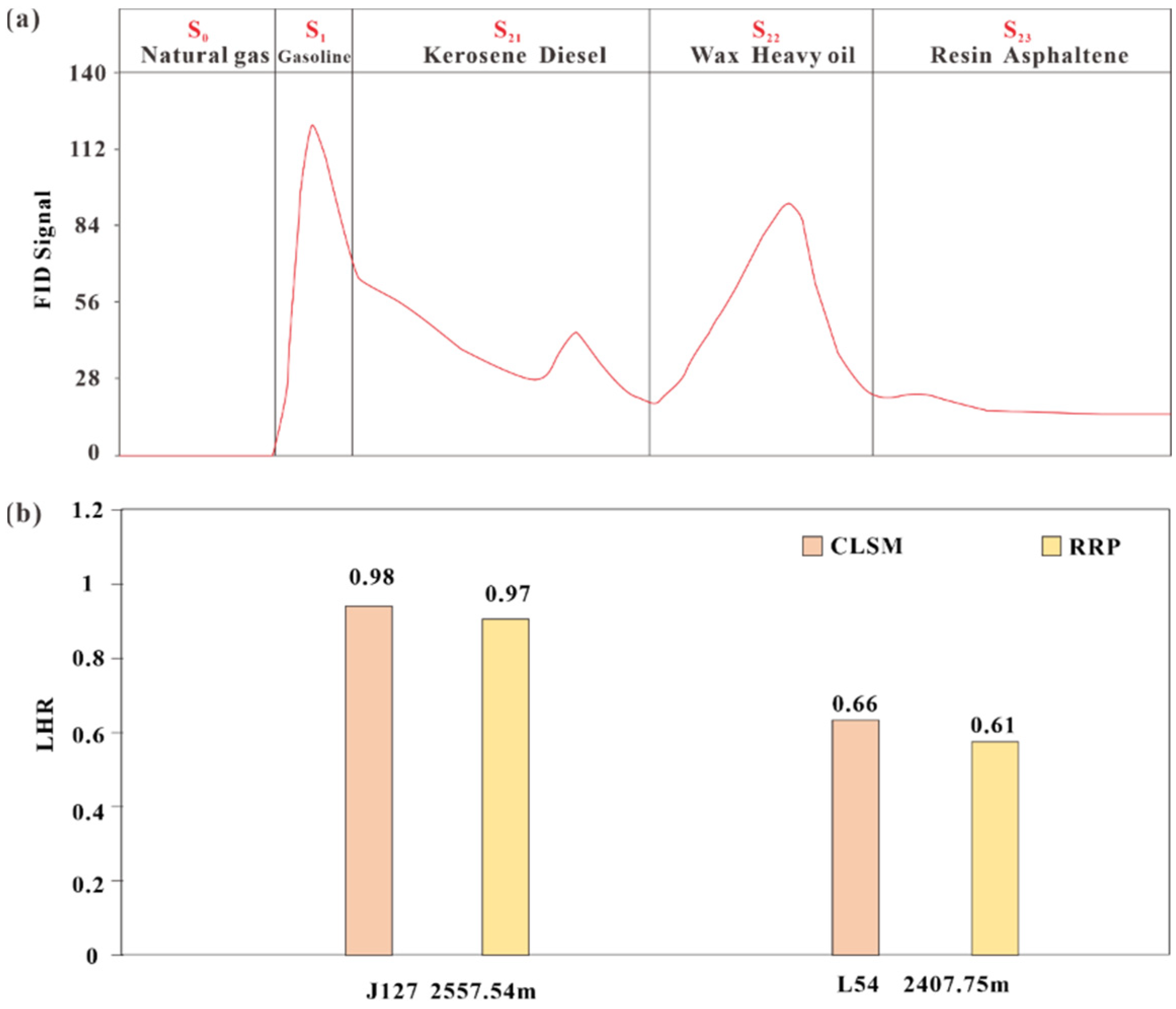
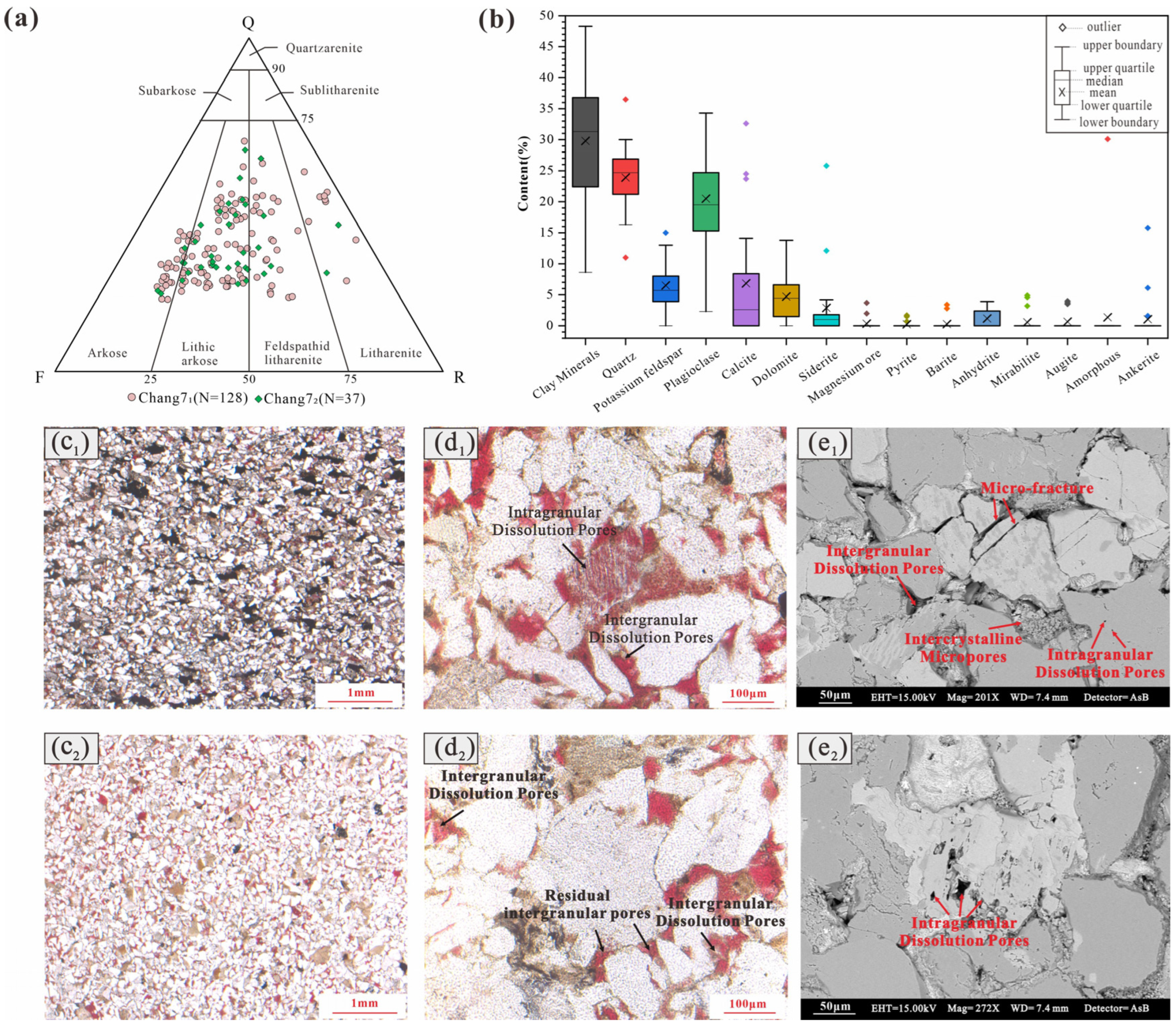
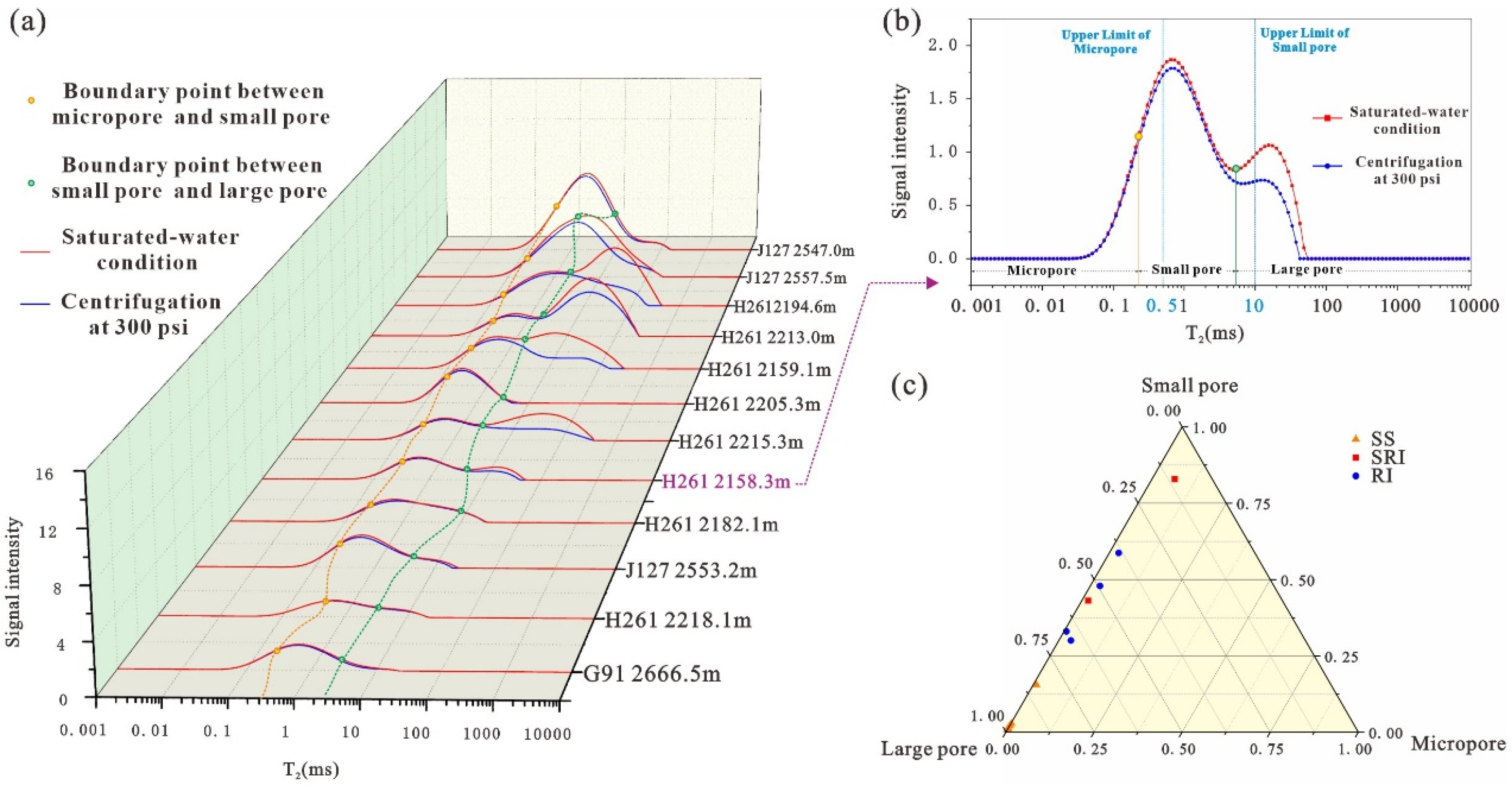
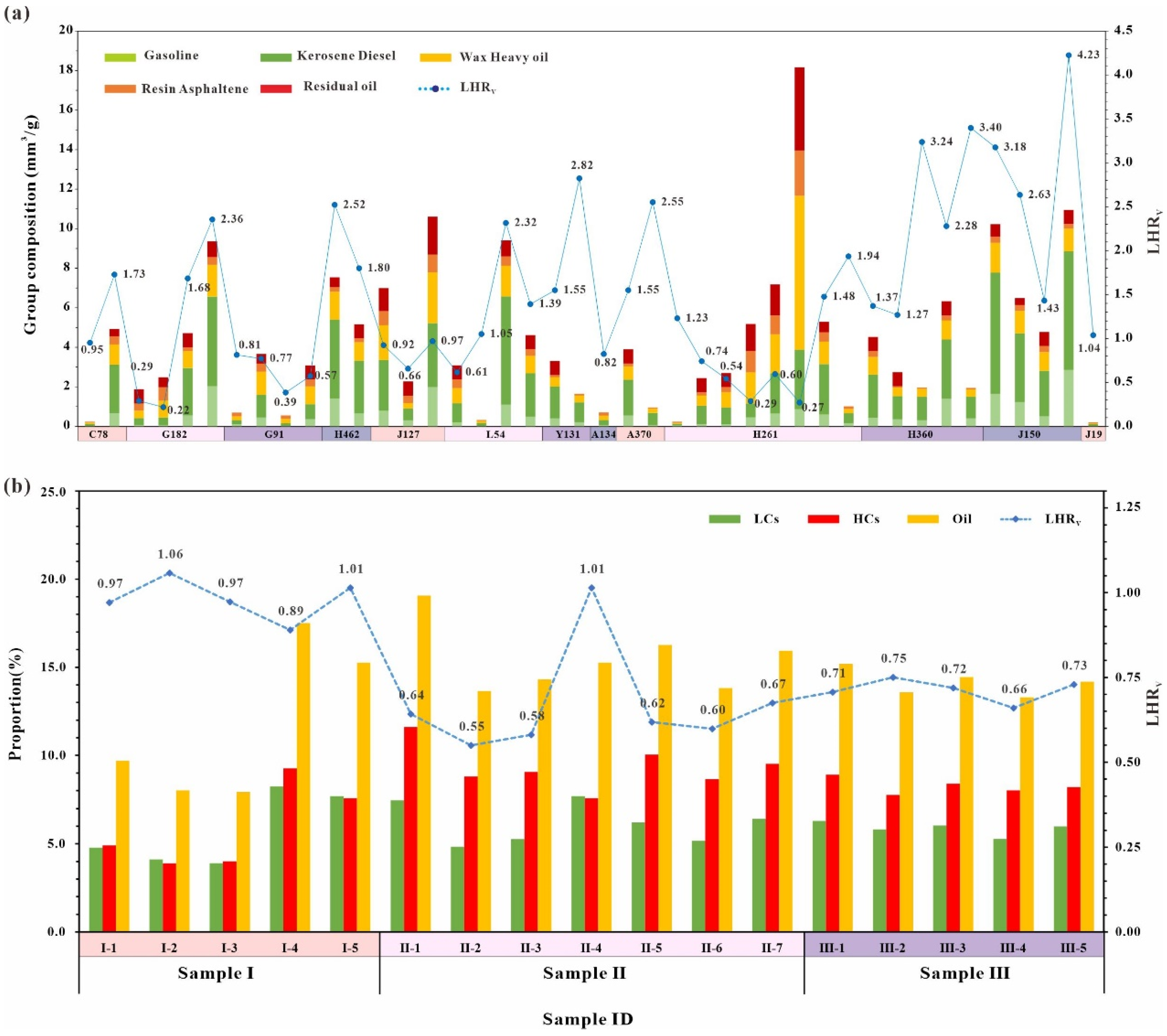



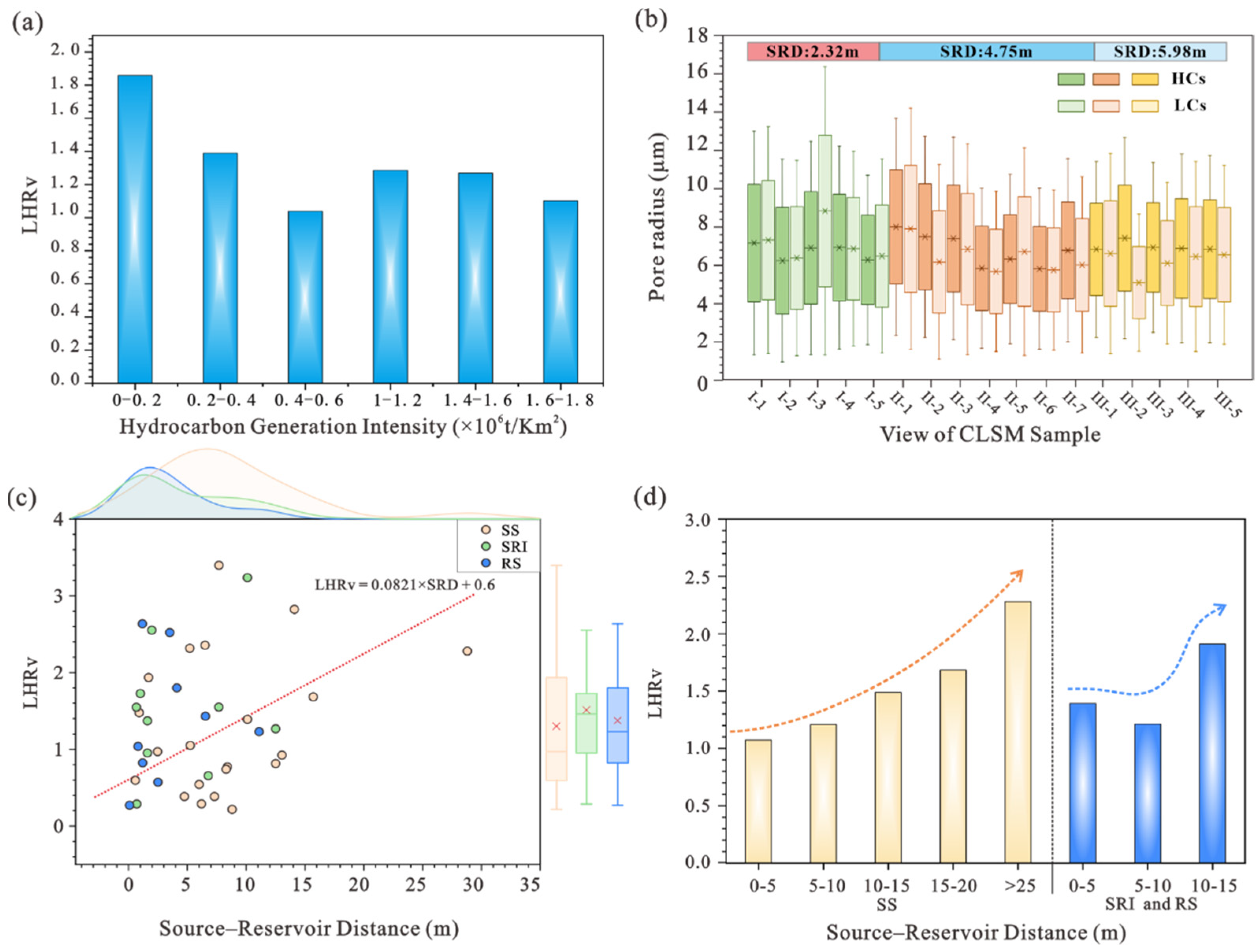




| Type of Crude Oil | Density | Interfacial Tension | Contact Angle | Mean Size Ratio of Pore and Throat | Maximum Hydrocarbon Generation Pressure |
|---|---|---|---|---|---|
| LCs-rich | 772 kg/m3 | 19.3 mN/m | 142° | 400 | 21 Mpa |
| HCs-rich | 842 kg/m3 | 30 mN/m | 180° |
Disclaimer/Publisher’s Note: The statements, opinions and data contained in all publications are solely those of the individual author(s) and contributor(s) and not of MDPI and/or the editor(s). MDPI and/or the editor(s) disclaim responsibility for any injury to people or property resulting from any ideas, methods, instructions or products referred to in the content. |
© 2025 by the authors. Licensee MDPI, Basel, Switzerland. This article is an open access article distributed under the terms and conditions of the Creative Commons Attribution (CC BY) license (https://creativecommons.org/licenses/by/4.0/).
Share and Cite
Jiang, M.; Chen, D.; Wang, Q.; Wang, F.; Wang, X.; Ma, K.; Wang, Y.; Lei, W.; Wang, Y.; Yang, Z.; et al. Occurrence Mechanism of Crude Oil Components in Tight Reservoirs: A Case Study of the Chang 7 Tight Oil in the Jiyuan Area, Ordos Basin, China. Energies 2025, 18, 1440. https://doi.org/10.3390/en18061440
Jiang M, Chen D, Wang Q, Wang F, Wang X, Ma K, Wang Y, Lei W, Wang Y, Yang Z, et al. Occurrence Mechanism of Crude Oil Components in Tight Reservoirs: A Case Study of the Chang 7 Tight Oil in the Jiyuan Area, Ordos Basin, China. Energies. 2025; 18(6):1440. https://doi.org/10.3390/en18061440
Chicago/Turabian StyleJiang, Mengya, Dongxia Chen, Qiaochu Wang, Fuwei Wang, Xiujuan Wang, Kuiyou Ma, Yuchao Wang, Wenzhi Lei, Yuqi Wang, Zaiquan Yang, and et al. 2025. "Occurrence Mechanism of Crude Oil Components in Tight Reservoirs: A Case Study of the Chang 7 Tight Oil in the Jiyuan Area, Ordos Basin, China" Energies 18, no. 6: 1440. https://doi.org/10.3390/en18061440
APA StyleJiang, M., Chen, D., Wang, Q., Wang, F., Wang, X., Ma, K., Wang, Y., Lei, W., Wang, Y., Yang, Z., Wanma, R., & Rong, L. (2025). Occurrence Mechanism of Crude Oil Components in Tight Reservoirs: A Case Study of the Chang 7 Tight Oil in the Jiyuan Area, Ordos Basin, China. Energies, 18(6), 1440. https://doi.org/10.3390/en18061440








